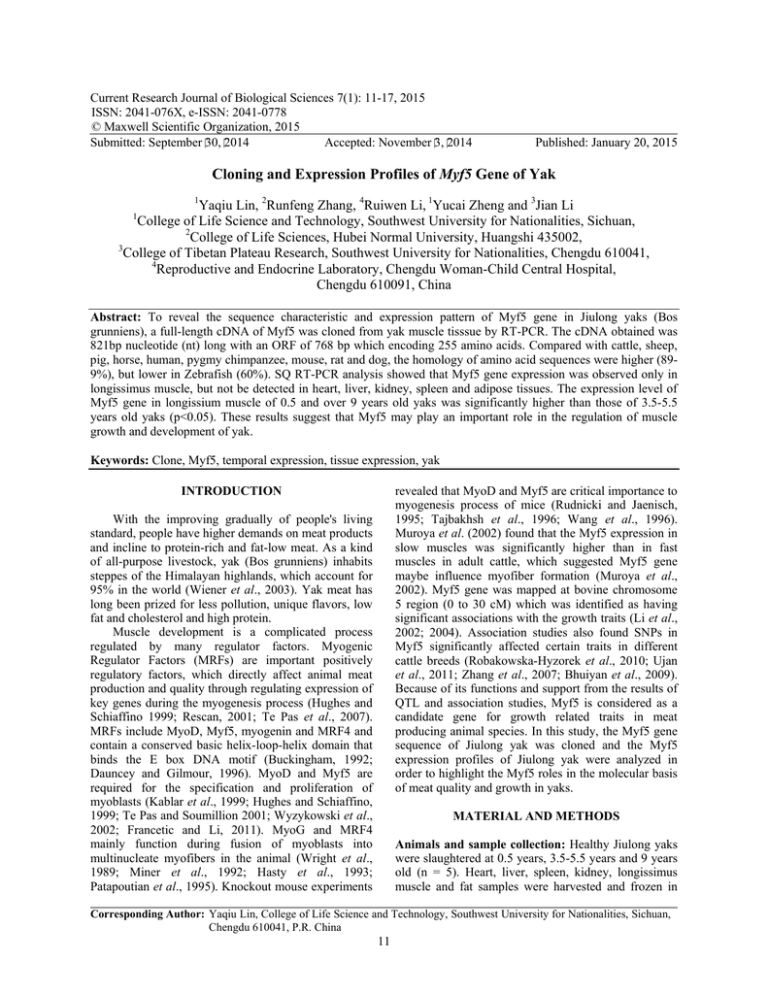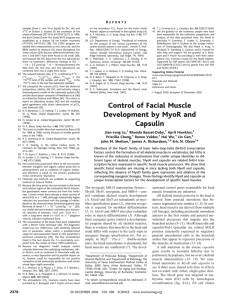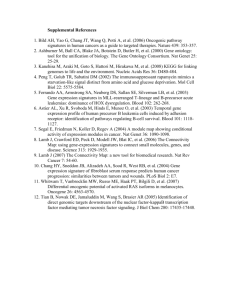Current Research Journal of Biological Sciences 7(1): 11-17, 2015
advertisement

Current Research Journal of Biological Sciences 7(1): 11-17, 2015 ISSN: 2041-076X, e-ISSN: 2041-0778 © Maxwell Scientific Organization, 2015 Submitted: September 30, 2014 Accepted: November 3, 2014 Published: January 20, 2015 Cloning and Expression Profiles of Myf5 Gene of Yak 1 Yaqiu Lin, 2Runfeng Zhang, 4Ruiwen Li, 1Yucai Zheng and 3Jian Li College of Life Science and Technology, Southwest University for Nationalities, Sichuan, 2 College of Life Sciences, Hubei Normal University, Huangshi 435002, 3 College of Tibetan Plateau Research, Southwest University for Nationalities, Chengdu 610041, 4 Reproductive and Endocrine Laboratory, Chengdu Woman-Child Central Hospital, Chengdu 610091, China 1 Abstract: To reveal the sequence characteristic and expression pattern of Myf5 gene in Jiulong yaks (Bos grunniens), a full-length cDNA of Myf5 was cloned from yak muscle tisssue by RT-PCR. The cDNA obtained was 821bp nucleotide (nt) long with an ORF of 768 bp which encoding 255 amino acids. Compared with cattle, sheep, pig, horse, human, pygmy chimpanzee, mouse, rat and dog, the homology of amino acid sequences were higher (899%), but lower in Zebrafish (60%). SQ RT-PCR analysis showed that Myf5 gene expression was observed only in longissimus muscle, but not be detected in heart, liver, kidney, spleen and adipose tissues. The expression level of Myf5 gene in longissium muscle of 0.5 and over 9 years old yaks was significantly higher than those of 3.5-5.5 years old yaks (p<0.05). These results suggest that Myf5 may play an important role in the regulation of muscle growth and development of yak. Keywords: Clone, Myf5, temporal expression, tissue expression, yak revealed that MyoD and Myf5 are critical importance to myogenesis process of mice (Rudnicki and Jaenisch, 1995; Tajbakhsh et al., 1996; Wang et al., 1996). Muroya et al. (2002) found that the Myf5 expression in slow muscles was significantly higher than in fast muscles in adult cattle, which suggested Myf5 gene maybe influence myofiber formation (Muroya et al., 2002). Myf5 gene was mapped at bovine chromosome 5 region (0 to 30 cM) which was identified as having significant associations with the growth traits (Li et al., 2002; 2004). Association studies also found SNPs in Myf5 significantly affected certain traits in different cattle breeds (Robakowska-Hyzorek et al., 2010; Ujan et al., 2011; Zhang et al., 2007; Bhuiyan et al., 2009). Because of its functions and support from the results of QTL and association studies, Myf5 is considered as a candidate gene for growth related traits in meat producing animal species. In this study, the Myf5 gene sequence of Jiulong yak was cloned and the Myf5 expression profiles of Jiulong yak were analyzed in order to highlight the Myf5 roles in the molecular basis of meat quality and growth in yaks. INTRODUCTION With the improving gradually of people's living standard, people have higher demands on meat products and incline to protein-rich and fat-low meat. As a kind of all-purpose livestock, yak (Bos grunniens) inhabits steppes of the Himalayan highlands, which account for 95% in the world (Wiener et al., 2003). Yak meat has long been prized for less pollution, unique flavors, low fat and cholesterol and high protein. Muscle development is a complicated process regulated by many regulator factors. Myogenic Regulator Factors (MRFs) are important positively regulatory factors, which directly affect animal meat production and quality through regulating expression of key genes during the myogenesis process (Hughes and Schiaffino 1999; Rescan, 2001; Te Pas et al., 2007). MRFs include MyoD, Myf5, myogenin and MRF4 and contain a conserved basic helix-loop-helix domain that binds the E box DNA motif (Buckingham, 1992; Dauncey and Gilmour, 1996). MyoD and Myf5 are required for the specification and proliferation of myoblasts (Kablar et al., 1999; Hughes and Schiaffino, 1999; Te Pas and Soumillion 2001; Wyzykowski et al., 2002; Francetic and Li, 2011). MyoG and MRF4 mainly function during fusion of myoblasts into multinucleate myofibers in the animal (Wright et al., 1989; Miner et al., 1992; Hasty et al., 1993; Patapoutian et al., 1995). Knockout mouse experiments MATERIAL AND METHODS Animals and sample collection: Healthy Jiulong yaks were slaughtered at 0.5 years, 3.5-5.5 years and 9 years old (n = 5). Heart, liver, spleen, kidney, longissimus muscle and fat samples were harvested and frozen in Corresponding Author: Yaqiu Lin, College of Life Science and Technology, Southwest University for Nationalities, Sichuan, Chengdu 610041, P.R. China 11 Curr. Res. J. Biol. Sci., 7(1): 11-17, 2015 tissues of Jiulong yaks as mentioned above. The primers were designed according to Myf5 mRNA sequences of yak (KC184118). Myf5-F: 5'CCATCCGCTACATTGAGAGTC-3', Myf5-R: 5'GGGCTGTTACATTCAG GCAT-3'. The β-actin primers were designed based on the sequence (BT030480). β-actin -F: 5'- CCCATCTA TGAGGG GTACGC-3', β-actin -R: 5'- CCTTGATGTCA CGGACGATTT -3'. Amplification was performed using the following cycling parameters: 94°C for 2 min, 33 cycles of 94°C for 30 s, 55.4°C for 30 s, 72°C for 30 s and 72°C for 1 min. After the reaction, PCR products were analyzed on 1.0% (w/v) agarose gels. liquid nitrogen jars for total RNA extraction. Animal studies were approved by the Southwest University for Nationalities Institutional Committee for the Care and Use of Animals. DNA cloning of yak Myf5 gene: Total RNA was isolated from the muscle tisssues of Jiulong yak using Trizol (Invitrogen) according to the manufacturer's recommendations. The quality of RNA samples were detected by ultraviolet spectrophotometer. First strand cDNA was synthesized using M-MLV reverse transcriptase (Thermo) and used as the template for PCR. The PCR primers were designed based on bovine Myf5 mRNA sequence in GenBank (NM_174116) as follows: F: 5'- ATGGACATGATGGACGGCTG -3' R: 5'-CTCCTTCCTCCTGTGTAATAGGC -3'. The PCR conditions were as follows: 94°C, 3 min, then 39 cycles of 30 s at 94°C, 35 s at 58.8°C, 1.0 min at 72°C; 7 min at 72°C. The PCR product was purified and cloned into pMD 18-T Vector (TaKaRa Biotechnology (Dalian) Co. Ltd.). Three positive clones were sequenced from both strands. Time-series expression of Myf5 gene in Longissimus muscles of Jiulong yak: Fluorogenic quantitative PCR assay was developed for the quantization of Myf5 mRNA level in Longissimus muscles of male yaks at ages of 0.5 yr (n = 5), 3.5-5.5 yr (n = 5) and over 9.0 yr (n = 5). The primers for Myf5 and β-actin were the same as above. The amplification mixture contained 10 mL SYBR® Premix Ex TaqTM (2×) (TaKaRa Biotechnology (Dalian) Co., Ltd.), 1 mL of RT reaction mix, 0.5 mL of 10 mmol/L each of primers and add ddH 2 O to 20 mL. The PCR conditions were as follows: one cycle of 1 min at 95°C; 45 cycles of 30 s at 95°C, 30 s at 55°C, 30 s at 72°C. Each sample was run in duplicate. Bioinformatics sequence analysis of Myf5 gene of Jiulong yak: The Open Reading Frame (ORF) of Myf5 gene of Jiulong yak was identified using ORF Finder (http://www.ncbi.nlm.nih.gov/gorf/gorf.html). The isoelectric point and molecular weight of the protein deduced from the nucleotide sequence were analyzed by ExPASy (http://www.expasy.org/tools). The conservative domain was predicted by NCBI tools (http://www.ncbi.nlm.nih.gov/Structure/cdd/wrpsb. cgi) and the signal peptide of the protein was predicted by SignalP 4.0 (http://www.cbs.dtu. dk/services/SignalP/) (Petersen et al., 2011). Amino acid sequence similarity analysis was performed by BLAST program (http://blast.ncbi.nlm.nih.gov/Blast.cgi) and BioEdit 5.0.6 (Hall, 2001); phylogenic tree was constructed by MEGA 6.0 (Tamura et al., 2013). Statistical analysis: Data were analyzed using SPSS17.0 and showed as mean±SEM. Differences were regarded as significant at p<0.05. The threshold cycle was analyzed using the 2-△△Ct method (Livak and Schmittgen, 2001). RESULTS AND DISCUSSION The nucleotide sequence of cDNA of Jiulong yak Myf5 was 821 bp (GenBank accession No: KC184118) and contained an open reading frame of 768 nucleotides, encoding a predicted protein of 255 amino acids with classic BHLH domain and no signal peptide (Fig. 1 and 2). Compared to bovine Myf5 sequence (NP_776541) (Table 1), Myf5 cDNA of Jiulong yak had four nucleotide differences resulting in an amino acid change. The deduced molecular weight was 28.26 KD and the theoretical pi was 5.72. Tissue expression of Myf5 gene of Jiulong yak: Quantization of Myf5 mRNA level in different tissues of male yaks at ages of 3.5-5.5 yr (n = 5) were assessed by RT-PCR using β-actin as internal control. Total RNA and cDNA were prepared from heart, liver, kidney, spleen, Longissimus muscles and adipose Fig.1: Prediction of biological function of the deduced amino acid sequence of Jiulong yak Myf5 12 Curr. Res. J. Biol. Sci., 7(1): 11-17, 2015 Fig. 2: Nucleotide sequence and deduced amino acid sequence of Jiulong yak Myf5; the primers used for the cloning of Myf5 gene were shaded. An asterisk represents the stop codon; the Basic domain of Myf5 was underline; The Helix-loop-helix (HLH) domain was boxed Fig. 3: The alignment of Myf5 amino acid sequences from caprine and other species Fig.3. The GenBank accession numbers of the Myf5 sequences are listed in Table 1.Amino acid sequence alignment of yak Myf5 with the predicted Myf5 sequences from six other mammals. The sequence alignments were performed using BioEdit version 5.0.6. 13 Curr. Res. J. Biol. Sci., 7(1): 11-17, 2015 Fig. 4: Phylogenetic tree of the amino acid sequences of Myf5 from yak and other mammals. The tree was constructed using the Neighbor Joining method in the MEGA version 6.0 software 1 2 3 4 5 6 Myf5 β-actin Fig. 5: Tissue distribution of Myf5 in Jiulong yaks (n = 5). (A) Myf5 cDNA in six tissues.1 Heart, 2 liver, 3 spleen, 4 kidney, 5 longissimus muscle, 6 adipose tissue . The Myf5 cDNA were obtained by semi-quantitative RT-PCR Multiple sequence alignments of the deduced protein sequences of Bos grunniens Myf5 with other Myf5 sequences were shown in Fig. 3. Bos grunniens Myf5 was 99% identical to Bos taurus, Ovis aries and Pantholops hodgsonii, 97% identical to Equus caballus, 96% identical to Sus scrofa, 95% identical to Homo sapiens and Pan paniscus and 89% identical to Mus musculus. A phylogenetic tree to assess the relationship of yak Myf5 with other known Myf5 was performed (Fig. 4). The Myf5 protein largely clustered into two major groups. The yak Myf5 grouped together with cattle as the closest neighbour, apart from Actinopterygii Myf5. In male adult yaks (3.5-5.5 yr, n = 5), the highest level of Myf5 mRNA was observed in Longissimus muscles among tissues examined (p<0.05), but Myf5 mRNA expression could not be detected in heart, liver, kidney, spleen and adipose tissues (Fig. 5 and 6). Expressions of Myf5 gene in Longissimus dorsi of 0.5 yr male yaks were apparently highest. Longissimus dorsi of 3.5-5.5 yr yaks contained significantly lower level of Myf5 mRNA than those of 0.5 yr and over 9.0 yr yaks (p<0.05) (Fig. 7). 14 Curr. Res. J. Biol. Sci., 7(1): 11-17, 2015 The relative expression level 1.60 a 1.40 1.20 a 1.00 0.80 0.60 b 0.40 0.20 0.00 0.5 3.5-5.5 Age(yr) >9 Fig. 6: The relatively levels of Myf5 mRNA in longissimus muscle of Jiulong yaks at different ages. The mRNA was detected by fluorescence quantitative PCR. Expression levels of Jiulong yak Myf5 gene in longissimus muscle at 0.5, 3.5-5.5 and 9 years old, respectively. Values without the same superscript are significantly different (P<0.05). Table 1: List of Myf5 sequences used in the analyses Organism Bos grunniens Bos taurus Ovis aries Pantholops hodgsonii Equus caballus Sus scrofa Homo sapiens Pan paniscus Callithrix jacchus Cavia porcellus Felis catus Ochotona princeps Rattus norvegicus Mus musculus Canis lupus familiaris Monodelphis domestica Pelodiscus sinensis Gallus gallus Xenopus laevis Danio rerio Ctenopharyngodon idella Salmo salar GenBank ID AGF90516.1 NP_776541.1 XP_004006268.1 XP_005953915.1 XP_001490053.1 NP_001265704.1 NP_005584.2 XP_003811708.1 XP_002752846.1 XP_003475964.1 XP_003989125.1 XP_004583120.1 NP_001100253.1 NP_032682.1 XP_852162.1 XP_001363986.1 BAE98137.1 NP_001025534.1 NP_001095249.1 NP_571651.1 ADB56965.1 NP_001117116.1 Main expression of Myf5 mRNA in Longissimus dorsi suggested that Myf5 gene play important roles during muscle development of yak. This result is inconsistency with previous studies on other animals. Daubas et al. (2000) showed that Myf5 was detected in muscle tissues, it was also persisted in the adult brain of mouse. Timmons et al. (2007) made the striking discovery that brown preadipocytes demonstrate a myogenic transcriptional signature. Johansen and Overturf (2005) and Ye et al. (2007) revealed that expression differences of Myf5 gene in different tissues are great between fish and mammals. Expression level of Myf5 are highest in muscles of rainbow trout and sea perch and it also could detected in heart, kidney, spleen, brain and gill tissues. In this study, meanwhile, level of Myf5 mRNA in Longissimus dorsi of 0.5 yr and over 9 yr male yaks were significantly higher than that of 3.55.5 yr male yaks. This maybe suggested that Myf5 works at early and latter stages of development in yak. However further work is needed to resolve molecular mechanism of Myf5 gene in muscle development of yak. group of Southwest University for Nationalities, Animal Science Discipline Program of Southwest University for Nationalities (2011XWD-S0905), Innovative Team Program of Hubei Normal University (2008) and Talent Introduction Program of Hubei Normal University (2007F14). Amino acid identity (%) 99 99 99 97 96 95 95 95 94 94 91 89 89 89 88 82 72 71 60 61 58 CONCLUSION In conclusion, we cloned Jiulong yak Myf5 gene and predicted the gene and deduced protein information. Furthermore, we analyzed the expression patterns of yak Myf5 and suggested that Myf5 may play an important role in the regulation of muscle growth and development of yak. REFERENCES Bhuiyan, M.S.A., N.K. Kim, Y.M. Cho, D. Yoon, K.S. Kim, J.T. Jeon and J.H. Lee, 2009. Identification of SNPs in MYOD gene family and their associations with carcass traits in cattle. Livest. Sci., 126(1-3): 292-297. ACKNOWLEDGMENT This study was supported by the Fundamental Research Funds for the Central Universities, Southwest University for Nationalities (13NZYQN23), Innovation 15 Curr. Res. J. Biol. Sci., 7(1): 11-17, 2015 Buckingham, M., 1992. Making muscle in animals. Trends Genet., 8: 144-149. Daubas, P., S. Tajbakhsh, J. Hadchouel, M. Primig and M. Buckingham, 2000. Myf5 is a novel early axonal marker in the mouse brain and is subjected to post-transcriptional regulation in neurons. Development, 127(2): 319-331. Dauncey, M.J. and R.S. Gilmour, 1996. Regulatory factors in the control of muscle development. Proc. Nutr. Soc., 55(1B): 543-559. Francetic, T. and Q. Li, 2011. Skeletal myogenesis and Myf5 activation. Transcription, 2(3): 109-114. Hall, T., 2001. Bioedit Version 5.0.6. Department of Microbiology, North Carolina State University. Retrieved from: http://www.mbio.ncsu.edu/Bio Edit/bioedit.html. Hasty, P., A. Bradley, J.H. Morris, D.G. Edmondson, J.M. Venuti, E.N. Olson and W.H. Klein, 1993. Muscle deficiency and neonatal death in mice with a targeted mutation in the myogenin gene. Nature, 364: 501-506. Hughes, S.M. and S. Schiaffino, 1999. Control of muscle fiber size: A crucal fact or in ageing. Acta Physiol. Scand., 167(4): 307-312. Johansen, K.A. and K. Overturf, 2005. Sequence, conservation and quantitative expression of rainbow trout Myf5. Comp. Biochem. Phys. B., 140(4): 533-541. Kablar, B., K. Krastel, C. Ying, S.J. Tapscott, D.J. Goldhamer and M.A. Rudnicki, 1999. Myogenic determination occurs independently in somites and limb buds. Dev. Biol., 206(2): 219-231. Li, C., J. Basarab, W.M. Snelling, B. Benkel, B. Murdoch and S.S. Moore, 2002. The identification of common haplotypes on bovine chromosome 5 within commercial lines of Bos taurus and their associations with growth traits. J. Anim. Sci., 80: 1187-1194. Li, C., J. Basarab, W.M. Snelling, B. Benkel, B. Murdoch, C. Hansen and S.S. Moore, 2004. Assessment of positional candidate genes myf5 and igf1 for growth on bovine chromosome 5 in commercial lines of Bos taurus. J. Anim. Sic., 82: 1-7. Livak, K.J. and T.D. Schmittgen, 2001. Analysis of relative gene expression data using real-time quantitative PCR and the 2−△△Ct method. Methods, 25: 402-408. Miner, J.H., J.B. Miller and B.J. Wold, 1992. Skeletal muscle phenotypes initiated by ectopic MyoD in transgenic mouse heart. Development, 114(4): 853-860. Muroya, S., I. Nakajima and K. Chikuni, 2002. Related expression of MyoD and Myf5 with myosin heavy chain isoform types in bovine adult skeletal muscles. Zool. Sci., 19(7): 755-761. Patapoutian, A., J.K. Yoon, J.H. Miner, S. Wang, K. Stark and B. Wold, 1995. Disruption of the mouse MRF4 gene identifies multiple waves of myogenesis in the myotome. Development, 121(10): 3347-3358. Petersen, T.N., S. Brunak, G. Heijne and H. Nielsen, 2011. SignalP 4.0: Discriminating signal peptides from transmembrane regions. Nat. Method, 8(10): 785-786. Rescan, P.Y., 2001. Regulation and functions of myogenic regulatory factors in lower vertebrates. Comp. Biochem. Physiol. Part B., 130(1): 1-12. Robakowska-Hyzorek, D., J. Oprzadek, B. Zelazowska, R. Olbromski and L. Zwierzchowski 2010. Effect of the g.-723G→T polymorphism in the bovine myogenic factor 5 (Myf5) gene promoter region on gene transcript level in the longissimus dorsi muscle and on meat traits of Polish holsteinfriesian cattle. Biochem. Genet., 48(5-6): 450-464. Rudnicki, M.A. and R. Jaenisch, 1995. The MyoD family of transcription factors and skeletal myogenesis. BioEssays, 17(3): 203-209. Tajbakhsh, S., D. Rocancourt and M. Buckingham, 1996. Muscle progenitor cells failing to respond to positional cues adopt non-myogenic fates in myf-5 null mice. Nature, 384: 266-270. Tamura, K., G. Stecher, D. Peterson, A. Filipski and S. Kumar, 2013. MEGA6: Molecular evolutionary genetics analysis version 6.0. Mol. Biol. Evol., 30(12): 2725-2729. Te Pas, M.F. and A. Soumillion, 2001. The use of physiologic and functional genomic information of the determination of skeletal muscle mass in livestock breeding strategies to enhance meat production. Curr. Genom., 2: 285-304. Te Pas, M.F.W., I. Hulsegge, A. Coster, M.H. Pool, H.H. Heuven and L.L.G. Janss, 2007. Biochemical pathways analysis of microarray results: Regulation of myogenesis in pigs. BMC Dev. Biol., 7: 66-80. Timmons, J.A., K. Wennmalm, O. Larsson, T.B. Walden, T. Lassmann, N. Petrovic, D.L. Hamilton, R.E. Gimeno, C. Wahlestedt, K. Baar, J. Nedergaard and B. Cannon, 2007. Myogenic gene expression signature establishes that brown and white adipocytes originate from distinct cell lineages. P. Natl. Acad. Sci. USA, 104(11): 4401-4406. Ujan, J.A., L.S. Zan, S.A. Ujan and H.B. Wang, 2011. Association between polymorphism of Myf-5 gene with meat quality traits in indigenous Chinese cattle breeds. Proceeding of the International Conference on Asia Agriculture and Animal (IPCBEE.2011), 13: 50-55. Wang, Y., P.N. Schnegelsberg, J. Dausman and R. Jaenisch, 1996. Functional redundancy of the muscle-specific transcription factors Myf5 and myogenin. Nature, 379: 823-825. 16 Curr. Res. J. Biol. Sci., 7(1): 11-17, 2015 Wiener, G., J.L. Han and R.J. Long, 2003. The Yak. 2nd Edn., FAO, Rome, Italy. Wright, W.E., D.A. Sassoon and V.K. Lin Myogenin, 1989. A factor regulating myogenesis, has a domain homologous to MyoD. Cell, 56(4): 607-617. Wyzykowski, J.C., T.I. Winata, N. Mitin, E.J. Taparowsky and S.F. Konieczny, 2002. Identification of novel MyoD gene targets in proliferating myogenic stem cells. Mol. Cell Biol., 22(17): 6199-6208. Ye, H.Q., S.L. Chen and J.Y. Xu, 2007. Molecular cloning and characterization of the Myf5 gene in sea perch (Lateolabrax japonicus). Dev. Biol., 312(1): 13-28. Zhang, R.F., H. Chen, C.Z. Lei, C.L. Zhang, X.Y. Lan, Y.D. Zhang, H.J. Zhang, B. Bao, H. Niu and X.Z. Wang, 2007. Association between polymorphisms of MSTN and MYF5 genes and growth traits in three Chinese cattle breeds. Asian-Aust. J. Anim. Sci., 20(12): 1798-1804. 17






